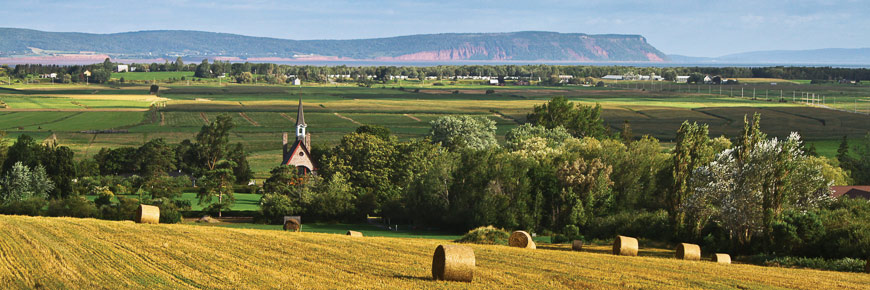
Cultural landscape
Grand-Pré National Historic Site
Today, the name Grand-Pré is applied to a loosely defined geographic area, which consists of several thousand acres of cultivated marshlands and gently rolling uplands containing farms, orchards and the continuous villages of Grand-Pré, North Grand-Pré and Hortonville.
National significance
The Acadians landscape, with its overlay of Planter cultural resources, continues to define the unique sense of place of Grand-Pré and the surrounding area. On June 20, 2004, the Historic Sites and Monuments Board of Canada unveiled a plaque commemorating the national significance of the Grand-Pré Rural Historic District.
The Dikes
The villages of Grand-Pré and Hortonville, and the fertile farmlands, which surround them, comprise one of the oldest settlement and land use patterns of European origin in Canada. Acadians began settling near Grand-Pré in the 1680s, attracted by the vast stretches of tidal marshes.
Employing ingenious dyke-building techniques developed at Port-Royal, Acadian farmers enclosed over one thousand acres of marshland which, when desalinated, created superior cropland. The houses of Grand-Pré village, scattered amidst the orchards and woodlots of the uplands fringe, stood along the southern boundary of the principal marsh.
The Planters
Following the Acadian deportation in 1755, a British township survey was superimposed on the area for the settlement of New England Planters, who adopted the existing marshland agricultural technology. The Planters' main settlement, which survives as the present villages of Grand-Pré and Hortonville, developed on the site of its Acadian predecessor. The combined agricultural traditions of the Acadians and the Planters have evolved to create the distinctive rural landscape of today's Grand-Pré.
Designation of a UNESCO World Heritage site in Canada
Inscribed in the prestigious UNESCO World Heritage in 2012, the landscape of Grand-Pré tells the remarkable story of the interaction of humans with their environment and gives an idea of how the link between a place and its inhabitants can define a collective identity.

The Landscape of Grand-Pré was designated by the World Heritage Committee for the following reasons:
Criterion (v): The cultural landscape of Grand-Pré bears exceptional witness to a traditional agricultural establishment, created in the 17th century by the Acadians in a coastal area with some of the strongest tides in the world. The reclamation used traditional dikes, ''aboiteaux'' and drainage system techniques, as well as a community management system still in use. The rich alluvial lands thus formed have enabled continuous and sustainable agricultural development.
Criterion (vi): Grand-Pré is the ideal memorial site of the Acadian diaspora dispersed by the Great Upheaval in the second half of the 18th century. Its polder landscape and archaeological remains bear witness to the values of a culture of pioneers who knew how to create their own territory, while living in harmony with the indigenous Mi’gmaq people. Its memorial constructions form a symbolic reappropriating of the land by the Acadians, in the 20th century, in the spirit of peaceful and cultural sharing with the English-speaking community.
Watch « Nomination Grand-Pré: One Land, Many Stories, A Shared Legacy » on Youtube- Date modified :